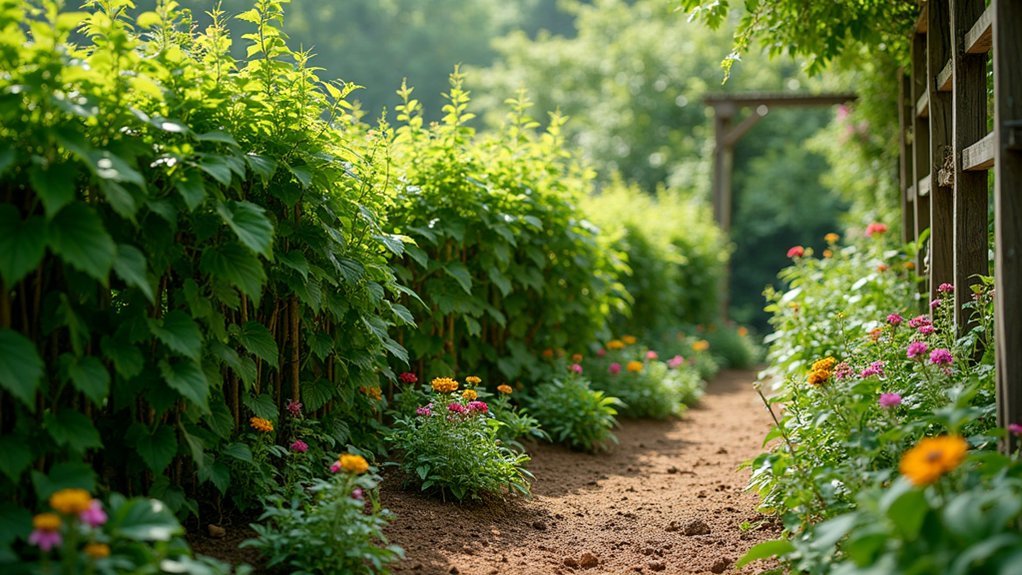Spring is the perfect time to revitalize your natural fence after winter damage. Start by clearing debris and inspecting for structural issues like wobbling posts or rot. Prune dead branches at 45-degree angles to encourage healthy growth, and apply organic mulch to boost soil health. Introduce companion plants like marigolds to naturally deter pests, and seal wooden elements with silicone caulk for weather protection. These simple strategies will transform your living barrier into a thriving boundary once again.
Winter’s Aftermath: Assessing Your Natural Fence

As winter’s icy grip finally loosens, your natural fence likely bears the battle scars of harsh weather conditions.
Begin your inspection by checking posts for wobbling or leaning caused by frost heave. Run your hands along wood surfaces to detect splits or splintering from freeze-thaw cycles. Freeze-thaw cycles can significantly weaken post stability and create ground movement that compromises your fence’s structural integrity.
Winter wreaks havoc on fence posts—check for leaning and run your fingers over surfaces to find weather damage.
Test each section for stability by gently pushing against panels to identify warping. Don’t overlook joints and fasteners, which often loosen during temperature fluctuations.
Use a moisture meter to reveal hidden water damage, and probe soft spots that might indicate rot or fungal growth.
Examine the foundation closely—look for soil erosion around posts and verify they haven’t shifted upward.
Pay special attention to areas where climbing plants may have trapped moisture or where tree branches rubbed against the fence during winter winds.
Clearing Debris: The First Step to Fence Renewal
Now that you’ve completed your fence assessment, it’s time to roll up your sleeves and tackle the accumulated debris. Clearing away branches, vines, and fallen leaves isn’t just about aesthetics—it’s essential for protecting your fence’s structural integrity and extending its lifespan by 5-10 years.
Start by removing vegetation that exerts pressure on your fence structure. This creates accessible perimeter space for proper inspection and maintenance while eliminating hiding spots for pests. Neglecting this task can lead to compromised fence integrity when branches push against your fencing materials.
- Use brush cutters (500-800 PSI for softwoods, 1,200-1,500 PSI for hardwoods) with protective gear
- Cut large debris into smaller pieces for efficient removal
- Clear away moisture-trapping materials that accelerate wood rot
- Remove climbing pathways for rodents and insects
- Create space for post-cleaning treatments like sealants that adhere better to clean surfaces
Pruning Techniques for Enhanced Spring Growth

When you’re pruning your natural fence this spring, remember that the type of cut you make greatly affects future growth patterns.
You’ll achieve fuller coverage by making proper heading cuts at 45-degree angles just above outward-facing buds, which encourages side branching.
Consider whether your fence needs renewal pruning (cutting back severely to rejuvenate) or simply maintenance pruning (selective thinning) based on its current condition and the specific plants in your living boundary. Always use sharp, clean tools to prevent disease transmission and ensure clean cuts that heal properly.
Pruning Cuts Matter
Making the right cut transforms an ordinary hedge into a vibrant, thriving natural fence. Your pruning technique directly impacts how your natural fence responds this spring. When you understand proper cutting methods, you’ll encourage dense growth while maintaining your fence’s health and shape.
- Make heading cuts at 45-degree angles above outward-facing buds to promote side branching.
- Use thinning cuts to remove entire branches, improving air circulation and light penetration.
- Implement rejuvenation pruning for overgrown sections to stimulate fresh growth.
- Clean and disinfect your tools between plants to prevent disease spread.
- Consider your fence’s natural growth habit when pruning to avoid unnatural distortion.
For thick branches in your natural fence, make cuts flush to the branch collar rather than flush with the main trunk to prevent decay and promote faster healing.
Remember to use sharp tools for clean cuts and wear protective gear when tackling thorny varieties. Your careful attention to proper cutting techniques will pay dividends in fence robustness.
Renewal Vs. Maintenance
Understanding the difference between renewal and maintenance pruning is essential for a thriving natural fence. While maintenance focuses on prevention rather than correction, renewal pruning rejuvenates your fence’s surrounding vegetation.
For maintenance, regularly remove debris like twigs and leaves to keep your fence environment clean. Different materials require specific cleaning methods, so adjust your approach accordingly. Cedar fences benefit from their natural oils that provide resistance to decay and require minimal upkeep.
Don’t neglect seasonal tasks—spring is ideal for inspecting winter damage.
For renewal pruning, timing is vital. Prune trees and shrubs during their dormant season to minimize stress. Trim back overgrown branches to prevent potential damage to your fence and maintain ground clearance for shrubs and ivy to avoid entanglement.
Remember that different species require unique pruning techniques, but proper execution enhances your garden’s aesthetics while maintaining fence visibility.
Soil Health: Nourishing Your Living Barrier
A thriving natural fence begins beneath the surface, where complex soil ecosystems support every aspect of plant health. Your fence’s vigor depends directly on soil quality, which you can enhance by balancing organic matter while avoiding over-composting clay soils that risk compaction. Loosening compacted soil improves water and air flow, creating an ideal environment for your natural fence to flourish.
Prioritize these soil health practices:
- Incorporate mycorrhizal inoculants to establish symbiotic relationships between fungi and your fence plants’ roots.
- Maintain a 2-4 inch mulch layer that preserves moisture without waterlogging.
- Plant deep-rooted species like juniper that naturally aerate soil and improve aggregate stability.
- Practice contour-aligned planting on slopes to maximize water retention and prevent erosion.
- Diversify your fence with nitrogen-fixing shrubs that feed the soil naturally.
Seasonal soil testing reveals micronutrient deficiencies before they affect growth, allowing targeted amendments before spring.
Natural Solutions for Pest and Disease Management

Your natural fence isn’t just a barrier—it’s a living ecosystem that needs protection from pests and diseases.
You’ll find organic deterrents like companion planting with marigolds and introducing beneficial insects such as ladybugs create a self-sustaining defense system.
Incorporating preventative measures like proper mulching and installing physical barriers can help you maintain a healthy, thriving fence without resorting to harmful chemicals. Regular routine inspections of your natural fence will allow you to catch signs of pest damage or disease early before they develop into larger problems.
Organic Deterrent Methods
Why rely on harsh chemicals when nature offers abundant solutions for fence protection?
You’ll find that organic deterrents not only protect your fencing but also support your garden’s ecosystem. Incorporate essential oils like lavender or tea tree by applying them to your fence posts, or create a natural barrier with companion planting using marigolds around your fence line. Many gardeners in the Pacific Northwest use beer traps near fence lines to control slug populations that can damage wooden structures over time.
- Apply neem oil to wooden fence components to naturally repel insect pests
- Create a perimeter of strong-smelling plants like garlic and ginger to deter larger pests
- Install sticky traps on fence posts to capture flying insects before they damage your fence
- Use untreated wood or bamboo for eco-friendly fence repair and extensions
- Refresh your deterrents seasonally, especially after heavy rainfall or extreme weather
Disease Prevention Strategies
Maintaining a healthy natural fence requires proactive disease management rather than reactive treatments. Start by implementing early detection systems—weekly inspections of foliage and root zones will help identify problems before they spread. Document any symptoms with photos to track progression.
Optimize plant health by applying balanced organic fertilizers in spring and mulching with compost to regulate soil moisture. Consider using native plants for your living fence as they typically have better pest resistance and are already adapted to local environmental conditions. Prune crowded branches to improve airflow and water at soil level to prevent leaf wetness.
Introduce beneficial microorganisms through mycorrhizal fungi and compost tea applications. For physical protection, install copper tape around fence posts and create gravel perimeters to reduce pathogen splashback.
Select disease-resistant varieties suited to your climate and adjust planting density based on local rainfall patterns to prevent overcrowding.
Reinforcing Structural Elements Without Compromising Nature
While strengthening your natural fence requires careful consideration of structural integrity, you don’t need to sacrifice environmental harmony in the process.
Combine traditional support methods with ecological awareness by implementing concrete footings for posts while integrating drought-resistant species nearby. For areas facing strong winds, install angled bracing systems that work with, not against, your living barriers. Remember that even the best-designed natural fence will provide visual screening but may offer limited sound insulation against neighborhood noise.
- Apply silicone caulk between posts and concrete for enhanced weather protection
- Incorporate coppicing techniques to encourage denser growth in young trees
- Use moisture-resistant treatments on wooden elements to extend their lifespan
- Install proper drainage to prevent water damage while nourishing plant barriers
- Consider multi-strand fencing alongside thorny shrubs for enhanced protection while maintaining aesthetic appeal
Encouraging New Growth in Sparse Areas

Sparse sections in your natural fence can become vibrant growth zones with targeted intervention strategies. Focus on improving growing conditions by enhancing soil quality with organic matter and guaranteeing proper water management for struggling plants. Prune dead branches to stimulate new growth and allow more sunlight to reach developing shoots. Consider adding panicle hydrangeas to sparse areas as they bloom on new wood annually, ensuring continuous growth and coverage even after hard pruning.
| Strategy | Benefit | Timeline |
|---|---|---|
| Close planting | Creates dense coverage | 3-6 months |
| Bamboo insertion | Rapid filling of gaps | 1-2 months |
| Vine integration | Adds texture & privacy | 2-4 months |
For quick results, introduce fast-growing species like photinia shrubs or privet hedges in bare spots. Experiment with osculation—tying neighboring branches together—to encourage natural fusion. Remember that regular maintenance, including weed control and pest management, will support your revitalization efforts and guarantee lasting privacy.
Weather-Proofing Your Fence for Spring Storms
As spring storms approach, your natural fence requires strategic weatherproofing to withstand heavy winds and rain. Inspect your fence now to identify vulnerable areas before the first downpour arrives.
- Install concrete footings around posts to prevent shifting during high winds and soggy soil conditions.
- Apply waterproof sealants or paint specifically designed for exterior wood to block moisture penetration.
- Create a shadowbox design that allows wind to pass through, reducing pressure and potential damage.
- Reinforce joints with steel brackets and additional fasteners at connection points.
- Remove accumulated debris from winter months to prevent rot and moisture buildup.
Remember to conduct regular post-storm inspections throughout spring. Addressing minor damage immediately prevents small issues from becoming costly repairs later, ensuring your natural fence remains both beautiful and resilient all season. Consider the regional climate when selecting appropriate weatherproofing products for optimal protection against your area’s specific seasonal challenges.
Frequently Asked Questions
How Do I Maintain a Natural Fence in a Coastal Environment?
To maintain a coastal natural fence, you’ll need salt-resistant materials like cedar, integrate dune plants for stability, apply marine-grade sealants yearly, and inspect monthly for damage. Regular cleaning removes corrosive salt buildup.
Can Children’s Play Areas Safely Border Natural Fences?
Yes, children’s play areas can safely border natural fences when you use non-toxic materials, maintain rounded edges, guarantee proper height, and conduct regular inspections. You’ll need to avoid toxic plants and prioritize visibility for supervision.
Which Native Plants Create the Densest Privacy Barriers?
For the densest privacy barriers, you’ll want American Holly, Wax Myrtle, Great Laurel, and Chindo Viburnum. These natives create impenetrable screens with their thick foliage and compact growth habits year-round.
How Often Should I Replace Aging Sections of Living Fences?
You’ll typically replace aging sections of living fences when you notice visible damage, disease, or gaps in coverage. With proper maintenance, you shouldn’t need complete replacements, just strategic renewal of weakened areas.
Are There Wildlife-Friendly Alternatives to Traditional Fence Treatments?
Yes, you can use non-toxic sealants, plant-based stains, or simply let fences weather naturally. Stone walls, living hedges, and untreated wood are excellent wildlife-friendly alternatives that avoid harmful chemicals entirely.
In Summary
Your natural fence deserves attention as much as your garden does. By tackling winter damage, pruning strategically, enriching soil, and addressing vulnerabilities now, you’ll create a thriving boundary that enhances your property all season. Don’t wait until problems multiply—your quick action this spring guarantees a robust, beautiful living fence that’ll weather whatever the year brings. It’s an investment in your landscape’s future.





Leave a Reply